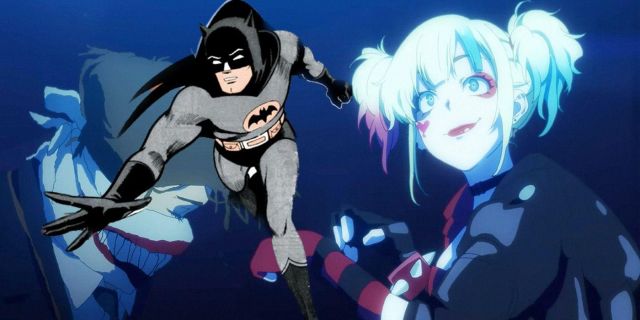The Suicide Squad Isekai announcement has sparked a lot of discussion within the anime fandom, as rather than being a traditional adaption of the stories found in DC’s comics, the team behind it has instead opted to go in a totally different direction. While this may seem strange on paper, the Suicide Squad Isekai is the latest in a long and storied tradition of Japanese creators taking DC’s legendary characters and putting a new twist on them. In fact, this tradition stretches back to the 1960s when Jiro Kuwata made a unique manga based on Batman.
How Did The Batman Manga Come To Be?

In 1966 the Adam West-fronted Batman TV show was aired on Japanese television, quickly becoming a big hit. Wanting to cash in on the popularity of this show, the magazine Shōnen King reached out to Jiro Kuwata, asking him to create a tie-in manga for their magazine.
Kuwata agreed to do this and was given a load of Batman comics and manuscripts to study. However, Kuwata believed that parts of these comics wouldn’t appeal to Japanese audiences, so after being told to interpret them any way he wished, he opted to rewrite them, often from the ground up, leading to the manga having little to no relation to the comics that inspired it. This is most notable with Batman’s rogues’ gallery, as while there are some familiar Batman comic book faces like Clayface, Catman, and The Outsider, the vast majority are exclusive to this manga, including The Human Ball, Planet King, Go-Go the Magician, and Lord Death Man.
However, once the manga concluded in 1967, it was mostly forgotten, with even DC’s management forgetting this manga existed. This changed in the early 2000s when Chip Kidd and Batman collector Saul Ferris pitched a book to DC Comics chronicling the Japanese Batman manga and other Japanese Batman products of the time. This book, dubbed Bat-Manga!: The Secret History of Batman in Japan hit shelves in 2008 and led to a renewed interest in the series, with several elements of the manga appearing in the mainline DC continuity. Then in 2014, the whole manga was reprinted and distributed in America.
What Makes The Batman Manga So Fascinating?

One of the most striking things about the manga is its visual style. Jiro Kuwata has always been a vocal fan of manga legend and Astro Boy creator Osamu Tezuka, and this influence is very apparent in the art. This style perfectly suits these stories, allowing Batman and Robin to be very expressive, even when wearing their costumes. Plus, the action sequences are brilliant as they are dynamic, thrilling, and fast-paced without ever feeling cluttered or hard to read.
Another unique thing about this manga is the stories it tells. Batman is presented as a talented detective like his American counterpart. However, the stories often venture into science fiction, with Batman frequently having to find a way to take down a villain using some powerful new technology, handle the results of mad science run amok, or find a way to recover some stolen device, rather than the high-camp wackiness of the Adam West Batman TV show. This direction does make sense in context because in 1964, in an attempt to boost flagging comic sales, DC introduced the “new-look” Batman, which attempted to return the character to his detective roots and move away from the more wacky adventures of the previous years. Due to the timing, it’s likely these “new-look” comics are the ones Kuwata used as inspiration. Plus, the “Science Detective” archetype was popular in Japan in this era, as seen by the success of the 1966 sci-fi kaiju anthology series Ultra Q, meaning that taking Batman in this direction made perfect sense.
These stories also feature a very unusual handling of Batman, as Kuwata’s interpretation of the character is much scrappier than the American version. While he is still an expert fighter and a genius in several fields, this Batman is frequently on the back foot as he lacks the hyper-preparedness of the modern incarnation. Because of this, he often gets beaten up by his foes and often falls for their tricks and traps, only winning the day with improvised desperation plays.
On top of this, the Batman manga also has a slightly different tone than other contemporary Batman media due to different cultural norms. This manga is more violent, as guns are frequently used, with Batman even getting shot at one point. Death is a common occurrence and is handled more bluntly, with some villains and the fates they inflict on their victims bordering on outright horror. In fact, you can draw a parallel between this manga and the Japanese Spider-Man TV series that aired during the 1970s, as that was also willing to go further than contemporary American Spider-Man media.
But one of the most fascinating things about the Batman manga is how it almost predicted the modern state of the character. This more-grounded, scrappy detective version of Batman would become the norm in the franchise’s later years, with movies like 2022’s The Batman feeling like the natural, modern evolution of the Batman seen in this series. While fans will debate if turning the Suicide Squad into an isekai is the right idea, it is continuing a long tradition of international studios taking American comic characters and putting a new spin on them that takes the story in a new, unforeseen direction. And, as the Batman manga shows, these versions can lead to fantastic, ahead-of-their-time tales that are as memorable as they are predictive of the future.















Leave a Reply